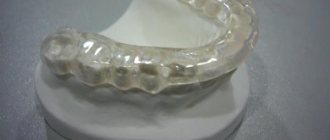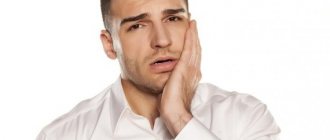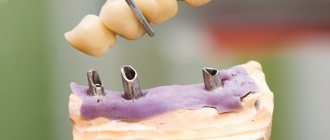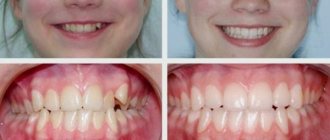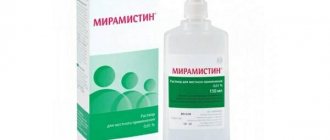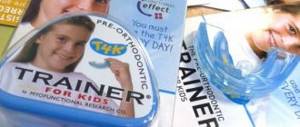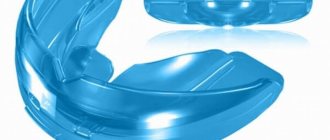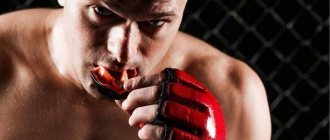The first trainers appeared 20 years ago; they began to appear on the market of our country only a few years ago, but literally after their appearance, due to their high efficiency, they began to be in demand among the population. Silicone and polyurethane are used to manufacture the device. These devices can be hard or soft. In short, various solutions are offered, which makes it easy to choose an option based on your preferences.
Of course, you can expect to get the maximum result only if the trainer is chosen correctly. Therefore, before making a choice, it is recommended to visit a dentist who will help you choose the most beneficial solution in your particular case. Externally, these devices are similar to a mouthguard; they consist of:
- tongue limiter;
- lip bumper;
- marker tongue;
- labial arch;
- recesses for teeth.
IMPORTANT! The products in question are versatile, so you do not need to waste time placing an individual order for production. With the help of this device, it is possible to painlessly and completely correct the bite, as well as straighten the dentition.
In addition, the use of this device allows you to set the correct position of the tongue in the oral cavity, eliminate speech defects, and establish proper swallowing and breathing. After use, it is guaranteed that the facial muscles will begin to function correctly, and relapse of orthodontic deviations will be completely excluded.
What are dental trainers?
Dental trainers are a double-jaw orthodontic device that tightly secures the upper and lower dentition, gradually correcting the incorrect position of the teeth, training the facial muscles and fixing the tongue in the correct position. The design has several components:
- outer part with lip bumpers;
- labial protrusion in the form of an arc;
- part in the oral cavity (tongue stop);
- “tongue”, which is located on the front part from the inside.
Types of bites that a trainer can help correct?
An orthodontic trainer is not the only device that corrects malocclusions. Only more expensive and complex devices can cope with difficult complex problems. The trainer is able to overcome the problem of improper nasal breathing or bad habits, as well as correct the following types of bite:
- Mesial
– when the lower jaw is moved slightly forward;
- Crowding
, in which the lower front teeth overlap each other;
- Open
– when the lateral or front teeth do not close together;
- Deep
– if the upper incisors overlap the lower ones;
- Distal
– if the upper jaw protrudes forward;
- Improper swallowing
;
- Speech disorders
.
What are dental trainers for?
A trainer for straightening teeth is usually prescribed to children aged 5 - 12 years, during the period of mixed dentition. Timely use of the device will eliminate serious problems in the future, since in adulthood, when the jaw bones are already formed, the bite can only be radically corrected through surgery. However, doctors warn that correcting teeth with trainers will only be useful if you follow the wearing regime. If a small patient is not motivated enough or his parents cannot control the process, the technique will not bring results.
A dental trainer for children is prescribed for the following indications:
- mouth breathing;
- parafunction of the tongue;
- bad sucking habits;
- improper eruption of front teeth;
- narrowing of the dentition;
- various malocclusions;
- pronounced crowding of teeth (the teeth do not have enough space on the gums, and they move each other).
Dental trainers are also used to treat patients over 12 years of age who already have a permanent bite. They are used for the following diagnoses:
- class II anomalies (subclasses 1 and 2, distal displacement of the lower first molar in relation to the upper one);
- crowding of the front teeth;
- deep or open bite.
An important purpose of trainers is to form the correct functioning of the jaw muscles, which is very difficult to achieve with the help of plates or braces. A separate function of silicone teeth trainers is retention after wearing braces. However, in most cases, trainers are prescribed to children.
Price
These devices are not an expensive pleasure and almost anyone can buy them. The average cost ranges from 2000 to 6000 rubles .
This significantly distinguishes the designs from brace systems, which are many times more expensive, especially those made of expensive materials or invisible to others.
The price depends on the number and cost of orthodontic consultations and the cost of the trainers themselves.
With the help of these devices, it is easy to correct malocclusions; it is important not to delay the start.
Trainers for teeth - children and adults
In pediatric and adult orthodontics, various models of trainers are used to straighten teeth, each of which has its own purpose.
Trainers for teeth T4K
For older children, T4K dental trainers, the so-called pre-orthodontic ones, are suitable. Treatment on such trainers takes place in two stages - first, the patient wears a soft initial device (blue), then, upon achieving the goals, it is replaced with a more elastic one (pink or red). T4K dental trainers are suitable for early and late mixed dentition. There are also models of trainers for teeth i-3 and i-2 and their varieties, specially designed for the treatment of class 2 and 3 anomalies.
Teeth Trainer T4A
T4A dental trainers are available as initial and final trainers. Initial (blue) is used on replacement teeth. It has a special recess so that the child understands where to put his tongue. This species is almost imperceptible in the mouth. The period of its use varies from 6 to 8 months. The final pink T4A dental trainer provides a more rigid hold on the dentition. You need to wear it for another 6 to 12 months.
Teeth trainer i-3
The i-3 teeth trainer is used to prevent bite defects during the early change of baby teeth. Its wearing period ranges from 4 to 8 months.
Teeth trainers T4A for adults
Orthodontic trainers for teeth T4A are in many ways similar to T4K for children, they are distinguished by slightly increased height of the sides of the labial arches and longer distal ends. Such devices are also available in two types of hardness - initial and final. Such trainers help in the cosmetic alignment of the front teeth and in minor relapses after orthodontic treatment.
Advantages and disadvantages of the method
Like any orthodontic method, installing trainers is not suitable for everyone; this device has its pros and cons .
- Children's devices are made in color to add emotions to the process of wearing them, while adults can undergo treatment without unnecessary attention to their smile, since the trainers of this line are most often colorless.
- The method does not cause much trouble to use, since the structures are often worn at night, and during the day they can be worn for only an hour and this will be enough for the process of straightening the teeth and easing muscle pressure.
- When using trainers, a person may not feel anything, since they do not create a feeling of discomfort.
- These devices are accessible to many; their price is an order of magnitude lower than the cost of braces or plates.
You can find out the prices for trainers for straightening teeth in adults in the following article.
In a separate publication we will talk about how to correct crooked teeth without braces.
Follow the link https://orto-info.ru/sistemyi-vyiravnivaniya-zubov/lechebno-profilakticheskie-apparatyi/treyner-t4a.html you will find reviews of the T4A trainer for adults.
How long and how to wear a dental trainer?
The duration of treatment with trainers will depend on the diagnosis. The minimum is 11 - 12 months. In some cases, after wearing trainers, further orthodontic treatment with braces or Invisalign aligners may be required. However, the period of additional treatment will be shorter than without first wearing dental trainers. How to wear a dental trainer? During treatment, the patient wears the device for at least an hour a day and wears it at night.
How to put on a dental trainer? To install the device, you need to place it with the “marker tongue” up and place it so that the tongue touches this “tongue”, then lightly press it with your teeth. Keep in mind that with the trainer installed in your mouth, you can only breathe through your nose. Before putting on an orthodontic trainer, you must thoroughly brush your teeth and wash the device itself with a cleaning agent.
What are they?
This is an elastic splint made of soft material, thanks to which the design fits almost any jaw. Trainers are used to correct malocclusion and abnormal tooth growth.
It has been proven that malocclusion is formed due to the active influence of the maxillofacial muscles on the dentition.
Trainers help reduce the intensity of this pressure and also help get rid of bad habits in children and adolescents, such as thumb sucking, pencil sucking and other objects.
Photo: orthodontic trainer on teeth
Appearance
There are several types of trainers for different purposes. Some are used for baby teeth, others during treatment with braces, and others simply to prevent the development of dental growth abnormalities.
They differ from each other in color. Multi-colored ones are often produced for children, and transparent ones for adults.
What problems do they solve?
These designs are necessary for the prevention and treatment of anomalies in the location of teeth in a row.
These devices are popular due to their action. They are made to eliminate not the symptoms of anomalies in the location of the jaw or teeth, but the reasons why the anomaly developed.
These orthodontic structures allow you to achieve a positive result and consolidate it at the same time . That is, their use minimizes the risk of relapse.
Doctors also prescribe these structures to help a person develop nasal breathing and to accustom the tongue to the correct position.
Trainer care rules
- The orthodontic trainer should be washed with running water after each meal, but it is contraindicated to use boiling water or ice water.
- The device must be cleaned at least twice a day with a brush and paste.
- The orthodontic dental trainer should be stored in a special container.
- The teeth straightening trainer should not be dropped, chewed or moved in the mouth while talking.
If cracks or damage appear on the device, it is necessary to immediately inform the attending orthodontist, since the structure may lose its properties, and bacteria may accumulate in the cracks.
Instructions for use
Installation of the device must be carried out strictly according to the instructions:
- Place the trainer in the oral cavity, pointing its “tongue” upward.
- Feel the “tongue” of the product with the tip of your tongue. In this case, there should be no pronounced discomfort.
- Squeeze the trainer slightly with your teeth until you feel it aligned and light pressure on the crowns.
- Close your lips tightly and try to breathe through your nose.
- While wearing it, you should not talk or chew.
Popular models
Dentists, for the correction of dentition, prescribe only proven models that allow them to successfully cope with problems. The most popular models include: T4K, T4A and T4B.
T4K
The T4K trainer is a device designed for the correction of temporary teeth or during their replacement .
The height and thickness of the walls of the device allows the child to practically not feel a foreign object in the mouth. In the front section of the trainer there is a special protrusion for the correct positioning of the tongue.
This design can be used to treat children with severe rhinitis, since there are two holes for breathing in the front wall.
The model is available in two versions: a blue trainer and a red (pink) trainer. The blue trainer is made of soft, elastic silicone, so it is used to begin treatment. Pink, has a rigid structure made of polyurethane, and is used as the main corrective apparatus.
The total duration of treatment with the T4K model is from 1 to 2 years. The average market cost of such a device is 3,700 rubles.
T4A
This type of device is intended for straightening teeth without the use of braces in adults and children over 10 years old, if at the time of treatment they have already formed a permanent bite.
The elastic design has a gentle effect on the crowns and additionally relieves muscle tone, correctly distributing the load on the jaw apparatus. In this case, a negative effect on the enamel and mucous membranes is excluded .
Selecting a T4A trainer will not be difficult, since models of only one universal size are available for sale.
Treatment with this device can last from 8 months to 3 years. Its cost is not much different from the first model and is generally 3,500 rubles.
Trainer for correcting malocclusion in children – MRC Trainer
Children's trainers MRC Trainer are of the following types:
- For milk bite - Infant Trainer
, for children 2-5 years old. The device helps develop the chewing structures of the dental system, develop nasal breathing, and correct tongue position. Trainers for primary occlusion allow the child’s teeth to develop correctly in order to save him from long-term treatment or wearing braces in the future. Trainers are available in a universal size and vary in hardness (at first it is recommended to use a soft one, and then, when the patient gets used to it, a harder one). - For late mixed dentition - T4K
. To correct the position of erupting teeth, as well as to get rid of bad myofunctional habits.
At the first stage of treatment, a trainer of a flexible design is used, at the second - a more rigid one, stimulating the development of dental arches and straightening the teeth.
Classification: types, their features and characteristics
- articular - restore the functionality of the temporomandibular joint, eliminate pain in the jaw muscles;
- for braces - prevent damage to gums by braces;
- finishing – consolidate the result after removing braces;
- sports - protect teeth when playing dangerous sports;
- for children - used for dental straightening of baby teeth;
- for adults - aimed at eliminating dental defects in permanent teeth without installing braces.
Each type has its own characteristics and characteristics.
Children's
Children's trainers eliminate the causes of incorrect bite formation. To do this, dentists use the following types of systems:
- T4K - initial or final. The initial one is a blue flexible, soft device. It is designed for replacing teeth, forming the correct position of the tongue. Wearing occurs at night and 60 minutes during the day for 6-8 months. The final one is a pink hard trainer, designed to change the blue one and continue the correction. Outwardly it resembles a wire arch in braces. It is worn at night for 6 to 12 months. In some cases, the doctor prescribes overnight wear, a longer course of treatment.
- T4A - for children over 10 years old. This model is made of silicone. Designed to straighten the frontal dentition without the use of additional systems. Helps eliminate defects in an already established dental bite. It is hypoallergenic and safe. Such a trainer is worn temporarily, taking into account the recommendations of the orthopedist.
- T4B is an intensive trainer. Enhances the effect of wearing braces by developing a natural tongue position when swallowing, talking, and sleeping. Additionally, it protects mucous membranes and strengthens the muscles of the mouth. Modern medicine offers universal samples that can easily be adjusted to individual characteristics. Designed to be worn night and day (no more than 1 hour) for a period of 6 to 12 months.
Important!
Positive dynamics are observed only with strict adherence to the regime of wearing trainers. However, the systems are not able to restore the position of teeth with extreme accuracy.
Adults
For adult patients, the T4A model is installed, but in a large Large size. The trainer has a complex structure, including three main elements:
- lip bumper - corrects the shape of the lips and smile line, reducing the tone of the facial muscles;
- central limiter - controls the position of the tongue, solves diction problems, partially eliminates grazing;
- pterygoid shape - supports the temporomandibular joint in an optimal position.
Soft trainers are intended for night wear, hard trainers for daytime wear. Prescribed to patients over 14 years of age.
Joint splints
These are trainers from the TMJ series. They have an arched shape made of high quality medical silicone. The material, in turn, is distinguished by elasticity and resilience, resistance to chemical compounds.
The sides are made in the shape of wings, which allows you to reduce pressure and relax muscle tension. The system is characterized by rapid adaptation to the individual characteristics of the human jaw. It does not cause discomfort, and the silicone ensures discreet wearing.
Dentists recommend wearing TMJ splints during the day for about 1-1.5 hours, all night. In practice, the patient experiences relief within two days.
Attention!
During the first few days, the patient wears the trainer for about 15-20 minutes so that addiction can form. Gradually the time increases. The general course can range from 2 to 7 months.
Finishing
Designed to consolidate achieved results. Such designs prevent the crowns from returning to their original position. Use them at night for 4-6 hours.
The distinctive features of the finishing trainer are its small shape and increased elasticity. It does not cause discomfort and is not addictive. The course lasts about 4-6 months.
Trainers for braces
These systems increase the effect of dental treatment with braces. They are distinguished by the presence of an elastic wall, which contains channels for the arc and locks of the fixed device. A braces trainer is prescribed if any complications have been diagnosed.
Dentists often recommend the use of such systems for second or third degree malocclusions with associated problems:
- pronounced underdevelopment of the lower or upper jaw;
- poor closure of the dentition;
- overlapping the lower row with the upper teeth;
- When closing, the incisors overlap.
The trainer not only solves these problems, but also forms the correct jaw arch. The device is successfully used to treat orthodontic problems in children and adults.
The fastening trainer is worn all night, one hour during the day. The exact period of treatment is prescribed by the dentist. In severe cases, the course lasts up to three years.
Trainers for bruxism
Prescribed when there are periodic attacks of contraction of the masticatory muscles during sleep and associated problems in the form of:
- pathological abrasion;
- increased sensitivity of bone tissue;
- inflammatory processes in periodontal structures;
- non-carious lesion.
Two types are used for treatment:
- Soft. This is a soft pad for younger children. It is often prescribed to adults with mild signs of the disease.
- Hard. A rigid product for adult patients suffering from severe bruxism.
Attention!
Trainers are not intended to treat bruxism. They can only eliminate symptoms and serve as a barrier against the occurrence of defects.
The sizes and duration of wearing are prescribed exclusively by the dentist individually for each patient.
